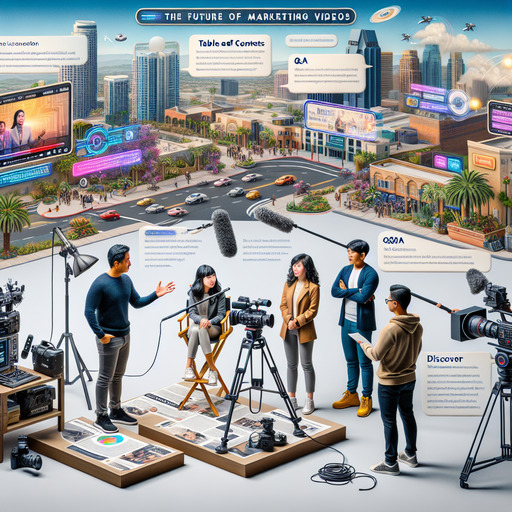
Table of Contents
Discover the Future of Marketing Videos: What’s Next? Learn More
Introduction
The future of marketing videos is poised to be transformative, driven by rapid advancements in technology and evolving consumer behaviors. As we move forward, several key trends are set to redefine how brands create and distribute video content. From the integration of artificial intelligence and machine learning to the rise of immersive experiences through augmented and virtual reality, the landscape is becoming increasingly dynamic. Personalized and interactive videos are expected to dominate, offering tailored content that engages viewers on a deeper level. Additionally, the proliferation of short-form video platforms and the growing importance of mobile-first strategies will continue to shape the way marketers approach video content. As these innovations converge, the future of marketing videos promises to be more engaging, data-driven, and impactful than ever before.
The Future Of Marketing Videos: What’s Next?
The future of marketing videos is poised to undergo significant transformations as technological advancements and consumer preferences continue to evolve. As we look ahead, it becomes clear that the integration of artificial intelligence (AI) and machine learning will play a pivotal role in shaping the landscape of video marketing. These technologies are already enabling marketers to create more personalized and engaging content by analyzing vast amounts of data to understand viewer behavior and preferences. Consequently, AI-driven video content can be tailored to individual viewers, enhancing the overall user experience and increasing the likelihood of conversion.
Moreover, the rise of augmented reality (AR) and virtual reality (VR) is set to revolutionize the way brands interact with their audiences. These immersive technologies offer unique opportunities for creating interactive and memorable experiences that go beyond traditional video formats. For instance, AR can be used to overlay digital information onto the real world, allowing consumers to visualize products in their own environment before making a purchase. Similarly, VR can transport viewers to entirely new worlds, providing an unparalleled level of engagement and emotional connection with the brand.
In addition to technological advancements, the growing popularity of short-form video content cannot be overlooked. Platforms like TikTok and Instagram Reels have demonstrated the power of concise, visually appealing videos in capturing audience attention. As attention spans continue to shrink, marketers will need to adapt by creating shorter, more impactful videos that convey their message quickly and effectively. This shift towards brevity will also necessitate a greater emphasis on storytelling, as brands strive to make a lasting impression in a limited timeframe.
Furthermore, the increasing importance of social media in the marketing ecosystem will continue to shape the future of video content. Social media platforms are constantly evolving, introducing new features and algorithms that influence how videos are discovered and consumed. To stay ahead of the curve, marketers must remain agile and continuously experiment with different formats and strategies to maximize their reach and engagement. This includes leveraging user-generated content, which has proven to be highly effective in building trust and authenticity with audiences.
Another trend that is expected to gain traction is the use of live video streaming. Live videos offer a sense of immediacy and authenticity that pre-recorded content often lacks, making them an ideal tool for fostering real-time interaction and engagement with viewers. Brands can use live streaming to host product launches, Q&A sessions, behind-the-scenes tours, and other events that create a sense of community and exclusivity. As internet speeds and streaming technologies improve, the quality and accessibility of live video content will only continue to rise.
Sustainability and ethical considerations are also becoming increasingly important in the realm of video marketing. Consumers are more conscious than ever about the environmental and social impact of their choices, and they expect brands to reflect these values in their marketing efforts. This means that marketers will need to prioritize transparency, inclusivity, and sustainability in their video content, from the production process to the messaging itself.
In conclusion, the future of marketing videos is set to be shaped by a combination of technological innovation, changing consumer preferences, and evolving social dynamics. By embracing AI, AR, VR, short-form content, social media, live streaming, and ethical considerations, marketers can create compelling and effective video content that resonates with their audiences and drives meaningful results. As the landscape continues to evolve, staying informed and adaptable will be key to navigating the exciting opportunities and challenges that lie ahead.
Q&A
1. **What are some emerging trends in the future of marketing videos?**
– **Interactive Videos**: Allowing viewers to engage directly with the content.
– **Shoppable Videos**: Enabling direct purchases from the video itself.
– **Personalized Content**: Tailoring videos to individual viewer preferences using AI.
– **Short-Form Content**: Increasing popularity of platforms like TikTok and Instagram Reels.
– **Live Streaming**: Real-time engagement with audiences.
– **Augmented Reality (AR) and Virtual Reality (VR)**: Creating immersive experiences.
– **360-Degree Videos**: Offering a more interactive and engaging viewing experience.
– **User-Generated Content**: Leveraging content created by consumers for authenticity.
– **Data-Driven Insights**: Using analytics to refine and target video marketing strategies.